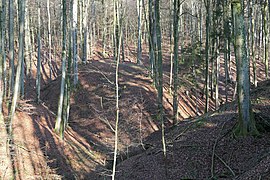Burgstall Waseneck
| Burgstall Waseneck | ||
|---|---|---|
|
The castle stables from the northeast. 2008 |
||
| Alternative name (s): | Wasenegg, Waslegg | |
| Creation time : | First mentioned in 1284 | |
| Castle type : | Niederungsburg | |
| Conservation status: | Burgstall | |
| Place: | Amesbach | |
| Geographical location | 48 ° 13 '46.7 " N , 14 ° 45' 14.9" E | |
| Height: | 303 m above sea level A. | |
|
|
||
The Burgstall Waseneck , also known as Wasenegg or Waslegg , refers to an abandoned castle in the municipality of Baumgartenberg in the Perg district in Upper Austria.
history
Waseneck was first mentioned in 1284 when it was passed on to Ulrich III by the Roman-German King Rudolf von Habsburg and Duke Albrecht I of Austria . von Capell († before 1315) is pledged. In 1423 Duke Ernst of Austria gave Reinprecht von Walsee Waseneck as a personal property . Then a Flußhart is known to have owned the fortress around 1440. He was followed by Veit Stetthammer, who owned Waseneck in 1473. As a result, the Sündecks and the Walchs were resident here. Gandolf Stundacker acquired the Waseneck fortress from the knight Hanns Walch zu Arbing in 1508 . In 1665 Waseneck and Außenstein came to Baron Johann Christoph von Clam-Martinic . The administration of goods was relocated to Clam Castle and Waseneck was left to decay.
Burgstall Waseneck today
The castle stables for this out-of-the-way festival is located in a forest in the village of Amesbach ~ 150 m northwest of the Amesbach property N ° 6.
The substructure is still clearly visible in the Zwiesel (confluence) of two channels. The plateau of the castle stables is surrounded on 3 sides by the deep trenches of the channel and measures ~ 65 × 30 m. The access to the plateau in the form of a neck ditch is to be found in the northeast. There is a modern spring version a little below and to the east. On the plateau itself there is a noticeable increase at the entrance. A little further on there was a conspicuous ring-shaped substructure on the plateau, diameter ~ 6 m. No monument protection (2020).
Picture gallery
literature
- Johann Samuelersch (Hrsg.): General Encyclopedia of Sciences and Arts (with Johann Gottfried Gruber ), 167 volumes. Leipzig 1818–1889.
- Georg Grüll : Castles and palaces in Upper Austria, Volume 1. Mühlviertel . 2nd Edition. Birken-Verlag, Vienna 1968, p. 145 .
- Christian K. Steingruber : A critical consideration of the historical-topographical manual of the fortifications and mansions of Upper Austria . Upper Austrian Provincial Archives , Linz 2013.
Web links
- Upper Austria State Library, data on castles, Waseneck, f. 48
- Province of Upper Austria, DORIS culture atlas, castles, Waseneck
Individual evidence
- ↑ Christian K. Steingruber , 2013, p. 236.





